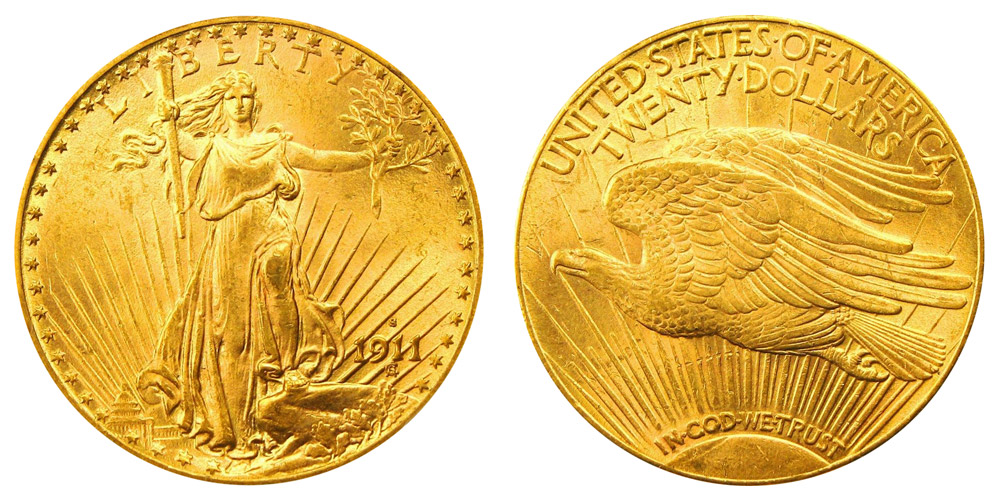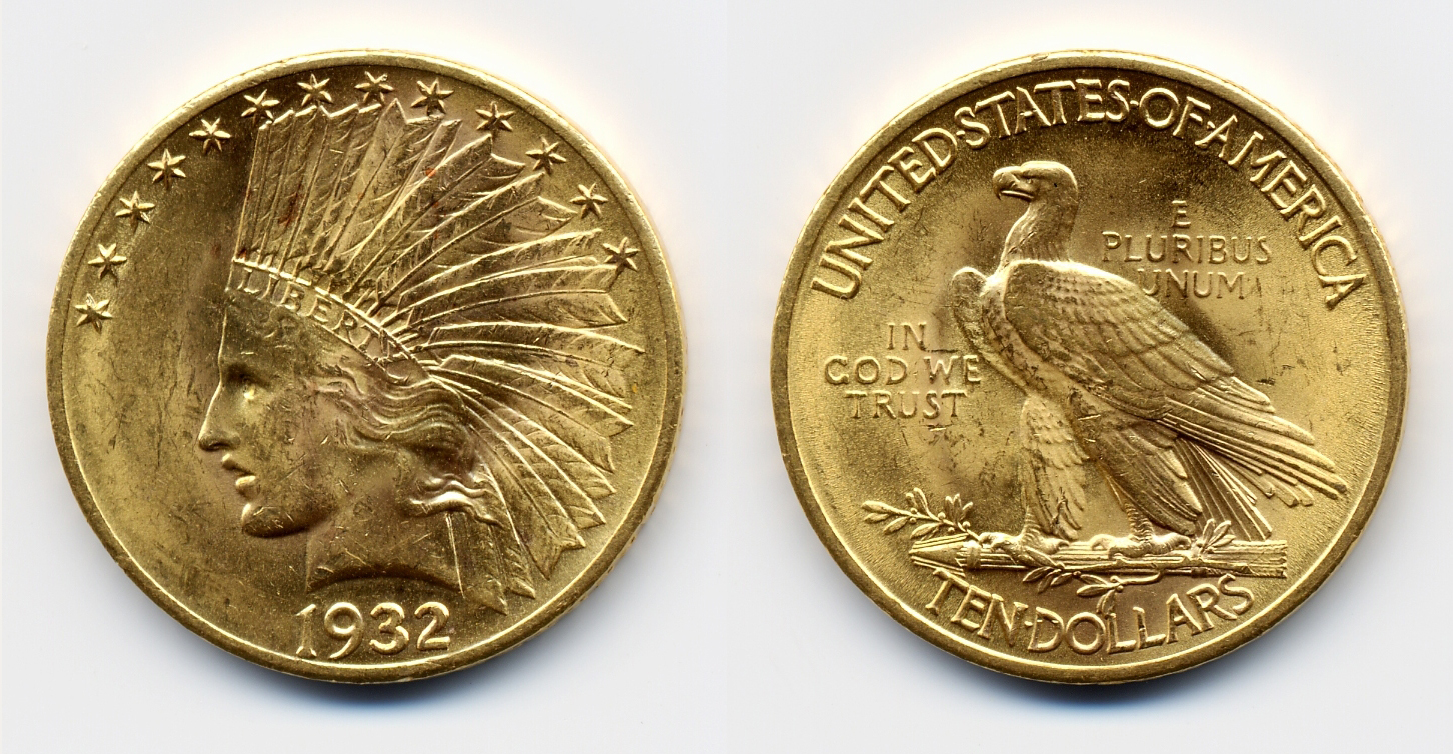What Is Pre-1933 U.S. Gold?
"Pre-1933 gold" refers to any legal tender gold coins made before the year 1933.
1933 is a crucially important date in the history of gold. It marked the end of circulating gold coinage in the United States.
The value of pre-1933 US gold coins is based on the coin’s gold content, its condition, and its rarity.

1911 s saint gaudens gold double eagle
Why did gold coins disappear in 1933? What ultimately happened to all of the pre-1933 gold coins? Read more below to find out!
You can buy pre-1933 U.S. gold for competitive pricing at Gainesville Coins.
How Much Gold Is In a Pre-1933 U.S. Gold Coin?
The amount of gold in pre-1933 U.S. gold coins was proportional to the denomination. So a $5 gold half eagle contained twice as much fine gold as a $2.50 quarter eagle, and so on.
With only the slightest variation, this holds true for all of the gold denominations, even the tiny gold $1 coin.
Here is the actual gold weight (AGW) of each pre-33 denomination, expressed in troy ounces.
| Denomination | Weight |
|---|---|
| Gold Dollar | 0.04837 oz |
| Gold Quarter Eagle | 0.12094 oz |
| Gold $3 Coin | 0.14512 oz |
| Gold Half Eagle | 0.24187 oz |
| Gold Eagle | 0.48375 oz |
| Gold Double Eagle | 0.9675 oz |
The Different U.S. Gold Coin Denominations
The denominations, or face values, of pre-1933 U.S. gold are unfamiliar to most. Below is a list of each coin and the date range it was minted.
- $1 Gold Dollar: 1849–1889
- $2.50 Gold Quarter Eagle: 1796–1929
- $3 Gold Coin: 1854–1889
- $5 Gold Half Eagle: 1795–1929
- $10 Gold Eagle: 1795–1933
- $20 Gold Double Eagle: 1850–1933
Both the gold dollar and $3 gold piece featured Indian Princess designs.
All of the remaining denominations used a variation of the classic Liberty Head design. In the early 20th century, these were replaced by two different Indian Head type designs.
The $20 double eagle received the biggest makeover in 1907 with the Saint-Gaudens design. It is sometimes known simply as the "$20 Saint."
How Much Is Pre-1933 Gold Worth?
In many cases, pre-1933 gold coins can be bought for very close to their melt value. Even coins in the higher circulated grades will sell for a rather low premium.
You can easily calculate the melt value of your vintage gold coin. Multiply the actual gold weight listed above by the current spot price of gold.
Graded or collectible gold coins from this era will tend to be more valuable. Collectors will pay a premium for such a coin, especially one in uncirculated condition. Prices will also depend on their availability on the market.
There are several rare gold coins from this era. Many became scarce as a result of widespread melting after 1933.
The best pricing resources to consult are:
Gold Confiscation: Executive Order 6102
The United States was deeply mired in the Great Depression by the time Franklin D. Roosevelt was elected president in 1932.
The depression was characterized by deflation—in other words, falling prices. One key way to combat this trend was to devalue the U.S. dollar.
However, the dollar was still backed by gold. A devalued dollar would cause gold prices to rise. In turn, this would lead people to hoard gold coins instead of spending them as currency.
To address this conundrum, President Roosevelt issued Executive Order 6102. This is colloquially referred to as the Gold Confiscation Act. It was among his first official actions upon taking office.

Executive Order 6102
The order did exactly what it sounded like: It allowed the government to seize virtually all privately held gold coins and gold bars.
A similar executive order was issued a year later in 1934 with respect to silver bullion.
Certain jewelry and some collectibles were exempt from seizure. The main purpose of E.O. 6102 was to demonetize gold coins. That is, it meant gold would no longer be used as currency.
Unsurprisingly, the Roosevelt administration then re-valued the official gold price from $20.67 per troy ounce to $35/oz. This was accomplished through the Gold Reserve Act in January of 1934. In effect, the value of the dollar was decreased significantly (by 70%, in fact) in gold terms.

The Beginning of the End for the Gold Standard
The system where gold coins circulated as money is known as a gold specie standard. Gold "specie" is simply a synonym for legal tender gold coins.
As you read above, gold confiscation effectively ended the era of gold specie. Yet you may be surprised to know that the gold standard remained in place. History shows the value of the dollar would still be tied to gold for the next four decades.
The form of the gold standard that followed was known as the Bretton Woods agreement. This system remained intact until 1971. Under Bretton Woods, rather than each country following a gold standard, the U.S. dollar would be redeemable in gold and other currencies were pegged to the value of the dollar.
This arrangement ended under President Nixon with the closing of the "gold window" in 1971. The United States government would no longer redeem dollars for gold. In 1974, the ban on private ownership of gold bullion in the U.S. was lifted.
The 1933 Double Eagle Is Illegal to Own
Another consequence of gold confiscation was the creation of some very rare coins. This is due in part to the large-scale melting of so many gold coins. For some dates and denominations, few examples escaped the melting pot.
The most famous rarity that resulted from the confiscation and melting is the 1933 double eagle.

1933 Saint-Gaudens double eagle
Approximately 450,000 double eagles were struck at the U.S. Mint in 1933. None of these coins minted were officially released for circulation. Instead, nearly all of them were melted down.
However, history shows that a handful of these coins did make it out of the mint. The most infamous example was once owned by King Farouk of Egypt.
Since these coins were never supposed to leave the mint, the U.S. government has deemed them illegal to own. The Farouk example is the only exception to this rule. The coin sold for over $7 million at auction!
Two more of these coins are on display in museums. Over the years, several other 1933 double eagles have surfaced and subsequently been seized by the government. The $20 Saint-Gaudens double eagle design also adds to their mystique.
If you want to find out more about the 1933 double eagle controversy, listen to our podcast on the topic.
Liberty Head Design
All of the classic 19th-century U.S. gold coins, across all denominations, used one form or another of the Liberty Head motif.
These depictions of Lady Liberty helped the United States Mint achieve the artistic ideal of uniformity. This style was popular throughout Europe at the time.
This desire for a uniform theme for a nation's coinage, as well as the classical artistic style used in gold coin designs of the 1800s, can be traced all the way back to the Ancient Greeks and Ancient Romans. The style is therefore referred to as "Greco-Roman" or "neoclassical."

The Liberty Head (or simply Liberty) designs show a profile portrait of Lady Liberty. She is facing left with her head tilted slightly upward. This differs from the European tradition of having the bust face right, and may be a subtle message of America's rejection of monarchy.
Most European powers of the time featured the image of the country's monarch on their respective gold coins.
The U.S. Liberty gold coins also bear the inscription "LIBERTY" along the bridge of Miss Liberty's tiara (or coronet) on the obverse (front) design. This is used in place of the name or titles of the king, queen, or emperor seen on foreign coins from this era.
The original Liberty Head motif that appeared on quarter eagles, half eagles, and eagles in the 1840s was designed by Christian Gobrecht. He served as the Chief Engraver of the U.S. Mint at the time.
Gobrecht is probably best-known for his Seated Liberty design that appeared on various denominations of US silver coins. Some collectors may be surprised to learn that his Liberty Head design continued to grace three gold coin denominations ($2.50, $5, and $10) until 1907.
Birth of the Liberty Double Eagle
Gobrecht passed away in 1844 and was succeeded as Chief Engraver by James B. Longacre.
A few years later, the California Gold Rush would give Longacre a great opportunity to leave his mark on American coinage.
Indeed, it would be a lasting impression that continues to captivate collectors to this day.
Due to the massive influx of gold coming from California in 1848 and 1849, the Congress decided to authorize a brand new coin denomination that first saw circulation in 1850: the Double Eagle.
As the name of the denomination implies, it was worth twice a gold eagle coin. The new $20 denomination soon became one of the most admired gold coins in the world at the time.
Although the gold double eagle was intended for circulation and regular commerce, the actual fate of these coins most often involved sitting in vaults as bank reserves or as bulk payments for America's debts overseas.
For this reason, a number of well-preserved hoards of Liberty Head double eagles have been discovered in recent years. Many were found stacked up in European bank vaults where they had been sitting idle for many decades.
Indian Head Eagle Design
In the early 1900s, President Theodore Roosevelt, decided that United States coinage was in need of some rejuvenation.
Roosevelt called for new artists to submit new coin designs.
Subsequently, Roosevelt commissioned Saint-Gaudens to create a few designs for U.S. coins.
The Indian Head eagles design has quite an interesting story behind it.
Saint-Gaudens, the chief designer for this new era of American coins, originally drew a portrait of Lady Liberty for the obverse of the $10 gold coins.
However, when Roosevelt was scrutinizing the Saint-Gaudens illustrations, he proposed something unexpected and unprecedented. Roosevelt wanted to have some sort of nod to the Native American, so he suggested adding a distinctive Native American headdress to the Liberty portrait.
Because he admired Saint-Gaudens’ work, but also wanted to honor Native Americans, Roosevelt asked Saint-Gaudens to make the addition while still keeping the original face, combining the two different symbolic traditions for something "picturesque" and "uniquely American."

Eventually, the changes were made and the Eagles we know today are referred to as Indian Head Eagles.
Because all U.S. gold coins were ordered to be confiscated and melted beginning in 1933, many of these remaining pre-1933 coins are far rarer today.
Gainesville Coins’ inventory of pre-1933 U.S. gold coins is constantly being updated, so check back often to see our latest offerings. We carry a wide range of dates and grades for pre-1933 U.S. gold.
